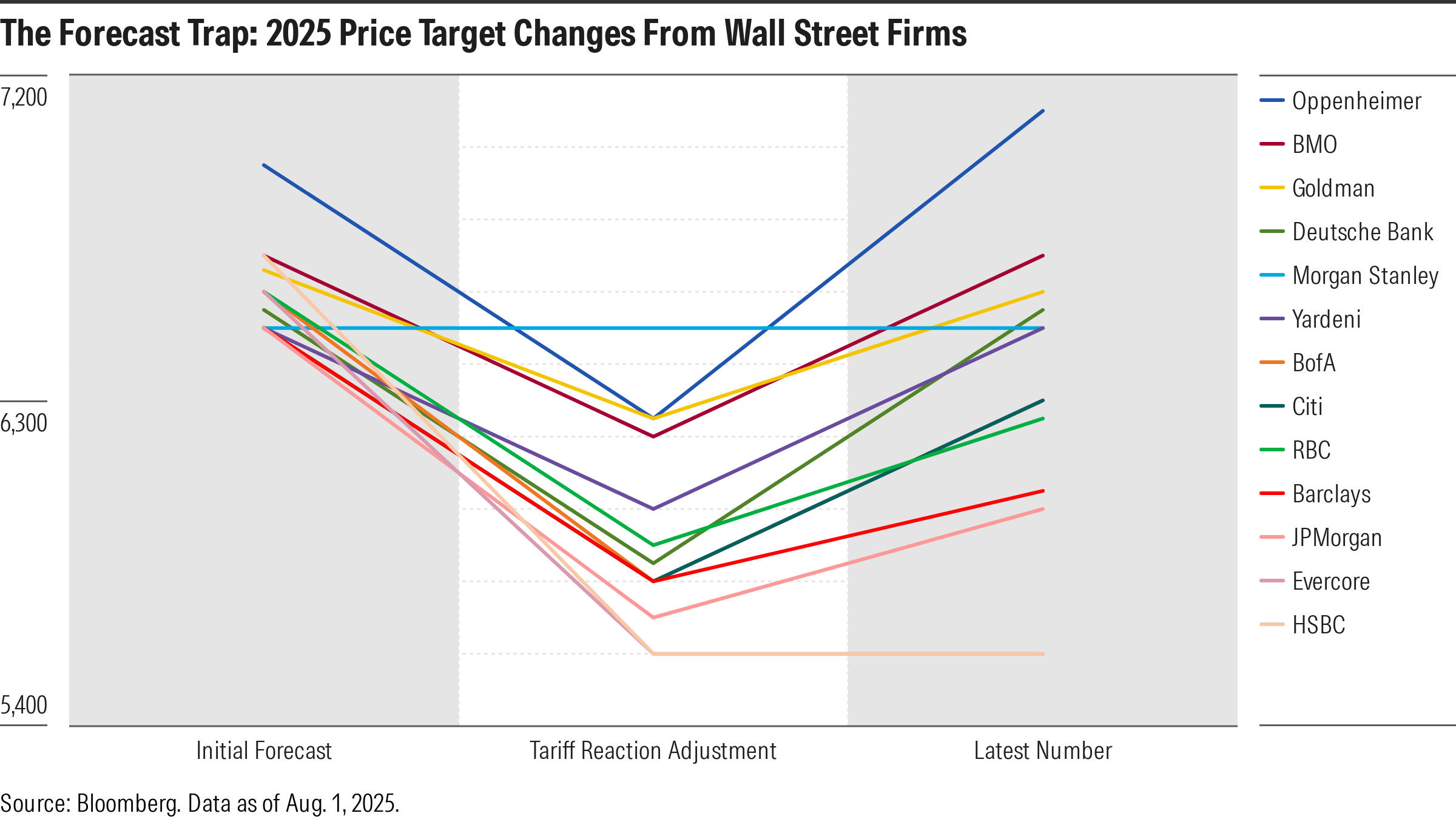9 min read
Morningstar’s 2026 Global Outlook for Investment Professionals

Key Takeaways
Help your clients shift their focus from short-term headlines towards long-term investment principles.
Reduce dependence on the Magnificent Seven and take advantage of more attractive valuations, like US small-cap stocks and European markets.
Show investors how to capture a fuller share of global growth while maintaining discipline and trust by exploring the convergence of private and public markets.
The unpredictability of markets has a way of humbling forecasters.
Markets never sit still. Geopolitics shift overnight. Economies seem to pivot without warning. And investor sentiment can turn on a dime.
Take 2025: Most firms set lofty expectations for US stocks at the beginning of the year, cut their targets after Trump’s tariff shock in April, then raised them again as prices recovered over the subsequent months.

The year ahead will present its own new challenges for the investing industry, like global concern over the decline of the US dollar, as well as a reinforcement of some of the usual suspects, including how to manage overexposure to the handful of mega-cap stocks powering the US market.
To ensure a portfolio serves the needs of investors in both good times and bad, it’s key to make sure it can withstand a range of unpredictable conditions.
In Morningstar’s 2026 Global Outlook, we unpack a variety of topics, including navigating inflation and income investing, incorporating semiliquid investments into portfolios, and exploring emerging markets like South Africa.
We’ll recap some of those topics for you in this article, and you can download the 2026 Global Outlook for free to further explore the deep, robust analysis and commentary from the Morningstar Research Team.
Look Beyond the Magnificent Seven for Returns
The concentrated group of mega-cap stocks known as the Magnificent Seven (Apple AAPL, Microsoft MSFT, Amazon.com AMZN, Meta Platforms META, Google GOOGL, Nvidia NVDA, and Tesla TSLA) have done a lot of the heavy lifting for the returns of the US market in recent years. But that concentration comes at the cost of less diversification and greater risk.
When a handful of stocks contributes so much to the market’s returns, portfolios tied to broad benchmarks can become less diversified than they appear: creating exposure to only a few business models, sectors, and factor profiles, which quietly dominate overall risk.

We believe investors should embrace opportunities to reduce their dependence on the Magnificent Seven—both inside and outside of the US—and take advantage of more attractive valuations.
We continue to favor US small caps, which have meaningfully lagged their large-cap counterparts over the past several years and trade at much cheaper valuations. Additionally, US healthcare stands out as an opportunity in an environment where most sectors appear fully valued. Download the 2026 Global Outlook for our top stock picks within the sector.
Private Markets: The Next Frontier in Investing
Private equity isn’t a new asset class—but it’s becoming more accessible.
As the number of public companies shrinks and private markets expand, advisors and investors are seeking ways to sensibly include exposure to private equity, private credit, and private real estate.
Semiliquid funds are one way to get access. These registered funds provide less-than-daily liquidity to investors and come in various structures, like interval funds, tender offer funds, nontraded business development companies, and nontraded real estate investment trusts.
_Global_Private_Fund_AUM_(USD)_800w_x_450h.png?format=webp&auto=webp&disable=upscale)
Exposure to earlier-stage companies and income-producing private credit introduces different sources of return and diversification to a portfolio, but their format and lack of liquidity also create challenges.
Traditional limited partnerships require capital calls, decade-long asset lockups, and patience through a “J-curve” of early negative returns—unfamiliar features for those accustomed to vehicles that are valued daily, like mutual funds and ETFs.
Preliminary simulations from Morningstar’s Wealth Forecasting Engine and private-market modeling framework suggest that adding 5–10% diversified private exposure to target-date glidepaths can raise median lifetime returns by 20–40 basis points annually. This indicates that measured allocations to private assets can enhance long-term outcomes when embedded into diversified, perpetual vehicles with prudent liquidity management.
However, semiliquid vehicles remain more expensive than traditional mutual funds, often two to three times higher when incentive fees are included. While higher simulated returns are promising, investors, advisors, and fiduciaries must balance them against the risks of higher costs, less transparency, and lower liquidity.
Navigating Market Uncertainty in 2026
Humans are naturally wired to react to uncertainty with action.
But the best approach to uncertainty in 2026 is to recognize biases, prepare for a wide range of economic outcomes, and ground investment decisions in a disciplined, time-tested framework.
Here are a few ways you can implement these practices with your clients—and yourself:
Avoid overreacting to headlines.
Rebalance and stay committed to your strategy.
Seek opportunities where markets have overcorrected relative to fundamentals.
Volatility-related events often prime us to fall into behavioral traps that can lead to costly investor mistakes. During these periods, advisors play a key role in helping clients avoid these mistakes, in part by guiding their attention to what truly matters.
For example, research from Morningstar’s Behavioral Insights Group found that, amid tariff uncertainty, the most common support clients wanted from advisors was market education.
Market education goes beyond just providing more information about current volatility. It means instilling the knowledge that investors need to make sense of events and helping shift their focus from short-term headlines toward long-term investment principles, emphasizing full market cycles and the value of staying invested over time.
Prepare for 2026 with Morningstar
The 2026 Global Outlook also explores investing opportunities in international markets like South Africa, Asia, and Australia, perspective on the booming AI industry, and the impact of the US dollar’s decline in value.
The upshot: Attempting to make definitive predictions about the year ahead can do more harm than good, but that doesn’t mean you can’t be prepared.
By equipping yourself with research, insight, and data, you’ll be better positioned to take advantage of new opportunities as they present themselves to you. Furthermore, you’ll be ready to educate your clients on the cyclical nature of the markets and the principles of long-term investing when headlines get noisy.
Download the report for free today to get a head start on next year.
What’s included:
- Preparing for 2026: Navigating Tariffs, Geopolitics, and Market Turmoil
- The Dollar’s Decline: Implication of a Weaker USD for Investors
- AI Arms Race: How Tech’s Capital Surge is Reshaping the Investment Landscape
- Beyond the Magnificent Seven: Unlocking Value in a Concentrated Market
- Investing for Income in an Uncertain Market
- Beyond the Budget, Black Holes, and Brexit – Investing in UK Assets
- Retirement Investing in Australia: Meeting Today’s Needs Without Sacrificing Tomorrow
- The Role of Private Assets in Your Portfolio
- Is South Africa the Missing Piece of Your EM Puzzle?
- Overlooked Long-Term Catalysts Beyond AI: China’s Anti-Involution



